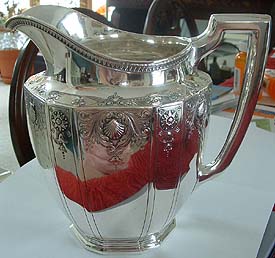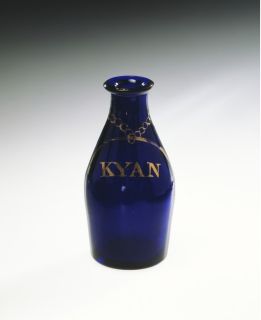
A teaspoon (tsp.) is an item of cutlery. It is a small spoon that can be used to stir a cup of tea or coffee, or as a tool for measuring volume. The size of teaspoons ranges from about 2.5 to 7.3 mL. For cooking purposes and dosing of medicine, a teaspoonful is defined as 5 mL, and standard measuring spoons are used.

A spoon is a utensil consisting of a shallow bowl, oval or round, at the end of a handle. A type of cutlery, especially as part of a place setting, it is used primarily for transferring food to the mouth. Spoons are also used in food preparation to measure, mix, stir and toss ingredients and for serving food. Present day spoons are made from metal, wood, porcelain or plastic. There are a wide variety of spoons that are made of a variety of materials and by different cultures for many different uses and foods.

Sterling silver is an alloy of silver containing 92.5% by weight of silver and 7.5% by weight of other metals, usually copper. The sterling silver standard has a minimum millesimal fineness of 925.

The Mildenhall Treasure is a large hoard of 34 masterpieces of Roman silver tableware from the fourth century AD, and by far the most valuable Roman objects artistically and by weight of bullion in Britain. It was found at West Row, near Mildenhall, Suffolk, in 1942. It consists of over thirty items and includes the Great Dish which weighs over 8 kg (18 lb).

Tableware is any dish or dishware used for setting a table, serving food, and dining. It includes cutlery, glassware, serving dishes, and other items for practical as well as decorative purposes. The quality, nature, variety and number of objects varies according to culture, religion, number of diners, cuisine and occasion. For example, Middle Eastern, Indian or Polynesian food culture and cuisine sometimes limits tableware to serving dishes, using bread or leaves as individual plates, and not infrequently without use of cutlery. Special occasions are usually reflected in higher quality tableware.

A salt cellar is an article of tableware for holding and dispensing salt. In British English, the term is normally used for what in North American English are called salt shakers. Salt cellars can be either lidded or open, and are found in a wide range of sizes, from large shared vessels to small individual dishes. Styles range from simple to ornate or whimsical, using materials including glass and ceramic, metals, ivory and wood, and plastic.

A cruet, also called a caster, is a small flat-bottomed vessel with a narrow neck. Cruets often have an integral lip or spout, and may also have a handle. Unlike a small carafe, a cruet has a stopper or lid. Cruets are normally made from glass, ceramic, or stainless steel.

Table manners are the rules of etiquette used while eating, which may also include the use of utensils. Different cultures observe different rules for table manners. Each family or group sets its own standards for how strictly these rules are to be followed.

The Hoxne Hoard is the largest hoard of late Roman silver and gold discovered in Britain, and the largest collection of gold and silver coins of the fourth and fifth centuries found anywhere within the former Roman Empire. It was found by Eric Lawes, a metal detectorist in the village of Hoxne in Suffolk, England in 1992. The hoard consists of 14,865 Roman gold, silver, and bronze coins and approximately 200 items of silver tableware and gold jewellery. The objects are now in the British Museum in London, where the most important pieces and a selection of the rest are on permanent display. In 1993, the Treasure Valuation Committee valued the hoard at £1.75 million.

A salt spoon is a miniature utensil used with an open salt cellar for individual service. It is a historical and nostalgic item from a time before table salt was free-flowing, as it is today. The spoon itself ranges from 2 to 3 inches long and has a circular bowl measuring approximately 0.5 to 0.75 inches. They can be found in a wide range of materials including glass, Sterling silver, plastic, wood, ivory, bone and shell.

A credence table is a small side table in the sanctuary of a Christian church which is used in the celebration of the Eucharist..

Salt and pepper shakers or salt and pepper pots, of which the first item is normally called a salt cellar in British English, are condiment dispensers used in Western culture that are designed to allow diners to distribute grains of edible salt and ground peppercorns. Salt and pepper shakers are sometimes held in a cruet-stand.

Salt and pepper is the common name for edible salt and ground black pepper, which are ubiquitously paired on Western dining tables as to allow for the additional seasoning of food after its preparation. During food preparation or cooking, they may also be added in combination.
A caster is a type of wheel.
Salt and pepper are a commonly paired set of condiments for European style cuisine.

A cruet-stand is a small stand of metal, ceramic, or glass which holds containers for condiments. Typically these include salt and pepper shakers, and often cruets or bottles of vinegar and olive oil. The stand and containers form a cruet set.

Customs and etiquette in Chinese dining are the traditional behaviors observed while eating in Greater China. Traditional Han customs have spread throughout East Asia to varying degrees, with some regions sharing a few aspects of formal dining, which has ranged from guest seating to paying the bill.















